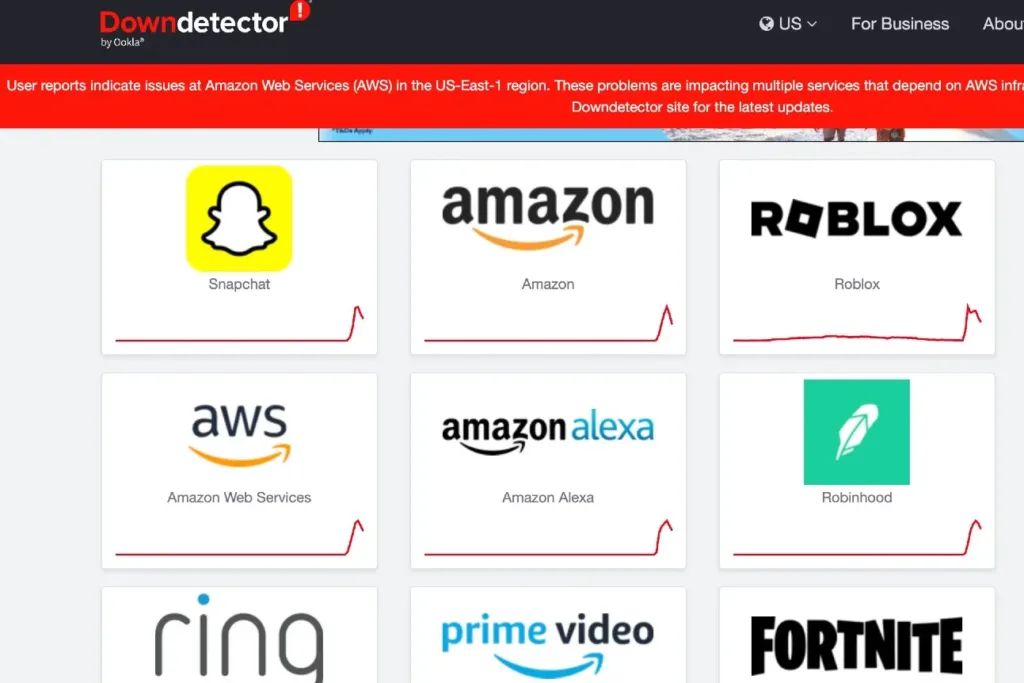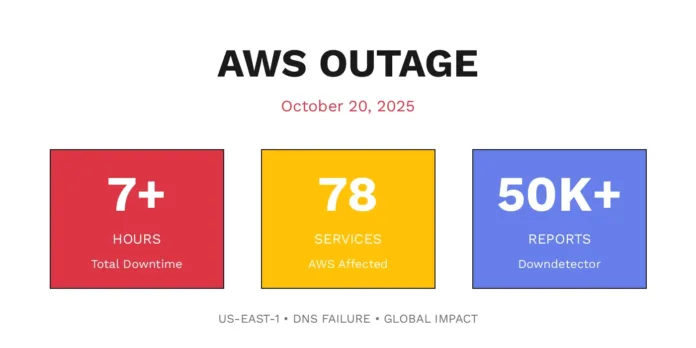Table of Contents
At Squaredtech, we track major technology disruptions and their impact across industries. Today we analyze the collapse of Amazon Web Services (AWS) that caused a massive internet outage. This Amazon cloud crash affected thousands of organizations and millions of users. Our aim is to break down the event, explain what happened, and discuss what it means for business and infrastructure.
Amazon Web Services Blackout: What Happened and How Big the Impact Was
Early Monday morning, the Amazon cloud crash struck when AWS systems on the U.S. East Coast malfunctioned. The crash affected key data-centre operations and triggered widespread service failures across many sectors. According to Downdetector a site that tracks internet outages—over 16 million individual user reports came in. More than 3,900 companies registered service disruptions.
The magnitude of this outage surpassed the earlier incident involving Meta Platforms’ apps (Facebook, WhatsApp, Instagram and Threads), which logged about 11 million user reports.
During the Amazon cloud crash, services such as national banking (for example, Lloyds Bank), public tax websites (such as HM Revenue & Customs in the UK) and consumer apps (such as Snapchat) went offline or malfunctioned for hours.
Read More About Our Article of Snapchat Imagine Lens: How AI Text Prompts Are Changing Creative Snaps Forever Published on September 6th, 2025 SquaredTech
AWS reported that the primary issue originated in how applications and websites connected to its database systems. The problem began on the U.S. East Coast, but because AWS serves global traffic, the disruption rippled worldwide.
Some services recovered in about three hours, but AWS acknowledged it had not fully resolved all issues until just before midnight—even after many users had regained access.
The number of UK-based outage reports reached about 1.5 million, second only to the roughly 6.3 million reports made in the U.S.
Consumer-facing brands such as Snapchat and e-commerce giant Amazon.com registered the highest volume of user complaints, alongside AWS itself and gaming platform Roblox.
Interestingly, even smart-home devices faced failures. For instance, the smart mattress maker Eight Sleep said users were unable to adjust their beds. Robot vacuums, smart alarms and other connected gadgets also malfunctioned because many rely on AWS tenancy for backend services.
This Amazon cloud crash serves as a stark reminder of how so many industries now depend on a single cloud service provider for critical infrastructure.
Why the Amazon Cloud Crash Matters for Business and Technology

As editors, we see three major lessons arising from this Amazon cloud crash event:
1. Concentration Risk Becomes Real
The AWS outage shows how concentration of services with a dominant cloud provider creates systemic risk. According to tech analyst Brent Ellis from Forrester, the incident revealed how highly inter-dependent many services have become on a single provider and a single geographic region.
“There’s great appeal to using tech giants but assuming they are too big to fail or inherently resilient is a mistake, with the evidence being the current outage and past ones.”
His words highlight the danger when dozens of companies, from finance to consumer apps, rely on the same infrastructure.
2. Operational Resilience Should Include Infrastructure Diversity
For many organizations, the Amazon cloud crash underlines that infrastructure resilience means more than backups or fail-over plans within one provider. True resilience means exploring multi-cloud strategies, regional fail-over capabilities, and independent data-flows. Businesses that placed “everything on AWS East Coast” found themselves vulnerable when that location went down.
From the data centre failure to the slow recovery, the event underscores that even top-tier cloud platforms are not immune from large-scale outages.
3. IoT and Cloud Dependencies Are Deep
The outage also shows how deeply many consumer devices depend on cloud services. Smart beds, robot vacuums, home monitoring systems—they all rely on backend cloud infrastructure to operate correctly. When the Amazon cloud crash hit core AWS services, apps and devices lost connectivity. Eight Sleep’s users reportedly could not adjust their mattresses.
For tech-companies and home-device manufacturers, this incident signals a need to reassess how dependent their systems are on single-vendor cloud infrastructures. For consumers, it raises questions about reliability when cloud services fail.
What Squaredtech Recommends After the Amazon Cloud Crash
From our perspective, organizations and technology teams should use this event as impetus for action. Here are three concrete steps:
- Audit your cloud dependency map
Determine which services rely on a single cloud provider or region. Note where your production, business-critical systems reside. Check whether you have fail-over or diversification strategies. The Amazon cloud crash shows that regional failure can cascade globally. - Develop multi-region or multi-cloud strategies
Consider distributing critical services across multiple cloud providers or regions within the same provider. Ensure that your data, apps and devices can fail over smoothly if one endpoint goes down. The outage highlights that even major providers can face long-duration interruptions. - Design IoT and device-forward architectures with resilience
If you build smart devices or connected-home systems, ensure that cloud-backend failure is not a single point of failure. Plan for local fallback modes or minimal operations when the backend fails. The Amazon cloud crash shows device manufacturers must assume occasional backend unavailability.
Closing Thoughts
We believe the Amazon cloud crash will shape thinking about cloud architecture for years. By showing how one single provider location can affect millions, the event challenges assumptions of “cloud is always available.”
Organizations should treat this as a wake-up call to build systems that tolerate failure rather than assuming perfect uptime. The lessons from this outage apply both to enterprise infrastructure and consumer device ecosystems.
If you are sourcing public-cloud infrastructure, supporting connected devices or simply relying on online platforms for critical functions, the Amazon cloud crash offers a moment to reflect, prepare and invest in stronger resilience.
Squaredtech will continue to monitor the fallout and provide updates on best practices for cloud architecture, infrastructure risk management and emerging dependency patterns.
Stay Updated: Tech News


